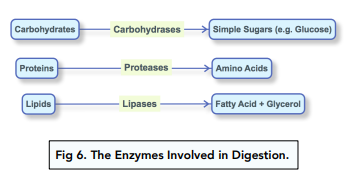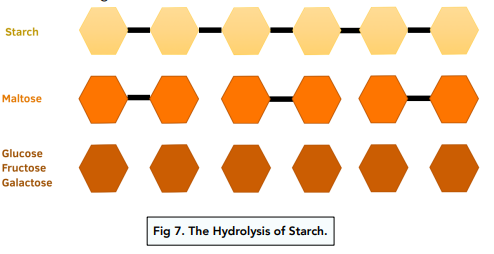Enzymes & Digestion - Carbohydrates: Breakdown and Synthesis (GCSE Biology)
Carbohydrates: Breakdown and Synthesis
Food Groups
- Foods are divided into three groups. Simply, all food can be divided into carbohydrates, proteins and lipids.
- These groups are made of different elements.
- Carbohydrates are made of carbon, oxygen and hydrogen.
- Large molecules (polymers) are made from smaller molecules (monomers).
- Starch, glycogen and cellulose are made from glucose
We will learn about the digestion of each of these groups below. This flow chart shows the three enzyme types involved in digestion of each food group:

Digestion of Carbohydrates
Function of Carbohydrases
- Carbohydrates are hydrolysed by carbohydrase enzymes. Carbohydrases are a class of enzymes that break down carbohydrates into simple sugars. They break carbohydrates down via hydrolysis. Hydrolysis is the break down of a large insoluble molecule, into a smaller, soluble molecule, using water.
- Carbohydrates are broken down in two stages. Starch in carbohydrates first broken down into maltose, and then maltose is then broken down into lots of smaller simple sugars such as glucose, fructose and galactose.

Location of Carbohydrases
Carbohydrate digestion happens in two key places:
- Mouth – in the mouth there is mechanical digestion via chewing, but also chemical digestion via saliva. Saliva produced by salivary glands contains a carbohydrate enzyme called amylase, which hydrolyses starch.
- Small intestine (duodenum) – The duodenum is the early part of the small intestine which connects the stomach to the small intestine. The pancreas produces a “juice” containing amylase which travels to the duodenum via the pancreatic duct. The amylase allows for further digestion of starch.
Tests
Test for Starch Using Iodine Solution
- Prepare your starch sample.
- Add iodine solution. This is an orange/brown colour.
- Analyse your results:
- If starch is present – sample will change colour from brown/
orange to blue/black - If NO starch is present – it remains brown/orange
- If starch is present – sample will change colour from brown/
Test for Reducing Sugars Using Benedict’s Solution
There are different types of sugars and some are classified as reducing sugars e.g. glucose. You can test for these sugars.
- Prepare your sugar sample.
- Add Benedict’s Reagent. This is blue.
- Heat in a 75 °C set water bath.
- Analyse your results:
- If a reducing sugar is present – coloured precipitate (solid) will be seen. The more concentrated, the further the colour change of the precipitate will be seen from blue (no reducing sugar present), to green, to yellow, to orange, to brick red (highly concentrated with reducing sugar).
- If a reducing sugar is NOT present – the solution will remain blue.
Enzymes are proteins that act as catalysts in chemical reactions. They speed up the rate of a reaction without being used up in the process. Enzymes play an important role in many biological processes, including digestion.
Enzymes play a crucial role in digestion by breaking down the large, complex molecules in our food into smaller, simpler molecules that can be absorbed by our bodies. Different enzymes are responsible for breaking down different types of food molecules, such as carbohydrates, proteins, and fats.
Carbohydrates are one of the three main macronutrients, along with proteins and fats. They are made up of carbon, hydrogen, and oxygen atoms and are an important source of energy for the body. Examples of carbohydrates include sugars, starches, and fibers.
Enzymes play a key role in the breakdown of carbohydrates. The enzyme amylase breaks down starch into smaller sugars, such as maltose and glucose. Other enzymes, such as lactase and sucrase, further break down these sugars into their individual sugar units.
After carbohydrates have been broken down into their individual sugar units, they are absorbed into the bloodstream and used by cells for energy. Glucose is the main sugar used by the body for energy, and it is transported to cells throughout the body where it is used to produce ATP (adenosine triphosphate), the energy currency of cells.
Synthesis is the process of combining smaller molecules to form larger ones. In biology, synthesis is an important process for the production of new molecules, such as proteins and carbohydrates.
Enzymes play a role in the synthesis of carbohydrates by catalyzing the reaction that combines smaller sugar units into larger sugars, such as starch and glycogen. These larger sugars are stored in the body for later use as a source of energy.
It is important to understand the role of enzymes and carbohydrates in digestion because they are central to the process of converting food into energy that the body can use. By understanding how digestion works, you can learn how to maintain a healthy diet and how to recognize and address digestive problems.






Still got a question? Leave a comment
Leave a comment